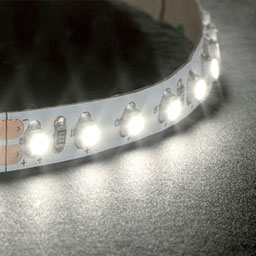Warping : why and how ?
This tutorial covers the wide warping subject.
First we will focus on what is Warping and how to use the tool, then we will see the tool in action in a concrete case.
The idea of warping is to stretch a media so it will perfectly fit the real word form.
Discovering the tool
We will use this regular grid to explain how the warping tool work.
![]()
And we will try to warp it on that grid :
![]()
So if we use the mapping tool, we can have a first approach like this :
If we look closer, we can see that the grid doesn't fit perfectly with the real life grid.
![]()
That's the aim of the warping tool.
In Millumin, you can activate the warping tool in the property panel on the right.
![]()
You can also select the number division needed to do the warping. There is no rule to determine how many divisions you need. Keep in mind that the more divisions you have, the longer the the warping will be.
Now you can replace the points exactly where you want them to be in real life.
The grid example is an easy one because the warping grid is regular.
But now imagine that you have something less regular like a building :
![]()
Here, placing the points would be a bit more complicated, mainly because some points of the grid are not on the points of interest of the building.
For that, we will open the slice editor and place the input points of the warping.
Once all your input points are placed, you can place the output points as you've done previously with the grid.
Warping use case
Their is a various way to use the warping tool, but one of the most common is the building projection.
When you plan to do a projection on a building, their are a few steps to follow. Mainly because you will prepare your files without having access to the projector to test them.
1 - Picture
So all the preparation will be made from a reference picture :
![]()
The idea when you take that picture is to be more or less at the position of the projector.
Their is no need to have a very high resolution picture, because in the end, you will be limited by the resolution of the projection.
If the photo is not straight, you can use any perspective tool to straight it.
Note that this can also be made with Millumin and exported by going in "Output→take screenshot...".
Note that as a good practice, the resolution of the image should be the resolution of the projection in the end.
2 - Tracing
Now, you will use this image to create you points of interest. Using a vector drawing software (inkscape, illustrator...) or Millumin mask tool, you need to trace every face of interest that will be used later in the projection :
Once you've traced every face of interest, you can export a reference svg file :
![]()
In the end, you should have a file like that one :
![]()
Note that not all the surfaces are covered. If you know in advance which surfaces will be used, so there is no need to trace everything. Remember that the more surfaces you have, the longer will be the setup.
3 - Create the content
Now, you can use that grid to create your content. For that you can use the software of your choice. After effect is a known leader for that kind of images, but feel free to use the one you like.
The important thing to always remember is that the format of the files that you create should be the same as the format of you traced document.
So the files should look like this.
4 - Prepare Millumin project
Once all the content is ready, you can prepare your project.
So create a new project and setup the resolution to the resolution of your projector(s).
Then import your reference file created in step 2, and on the same layer all the files you've created in step 3.
![]()
Now, activate the warping option and select the number of divisions needed.
For this example 5*8 should be ok.
Next you can open the slice editor and place your input point on your reference file.
As the other files are created using the same reference, the point would be the same.
Then, you can close the slice editor, and your work area should look like this :
![]()
You're project is now ready to go in the field !
5 - D-day : warping
Now, you can go on location and install your projector(s).
Once that's done and the physical configuration is made, you can start by doing a mapping of the four corners of the image so it roughly fit with the building.
Then you can replace your points of interest at the correct position :
Once your happy with the warping, you can launch the medias in the other columns and see the result :
You're done !

 Millumin Help
Millumin Help












































